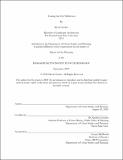| dc.contributor.advisor | Karilyn Crockett. | en_US |
| dc.contributor.author | Zucker, Meesh(Meesh Lauren) | en_US |
| dc.contributor.other | Massachusetts Institute of Technology. Department of Urban Studies and Planning. | en_US |
| dc.date.accessioned | 2021-01-05T23:16:18Z | |
| dc.date.available | 2021-01-05T23:16:18Z | |
| dc.date.copyright | 2020 | en_US |
| dc.date.issued | 2020 | en_US |
| dc.identifier.uri | https://hdl.handle.net/1721.1/129065 | |
| dc.description | Thesis: M.C.P., Massachusetts Institute of Technology, Department of Urban Studies and Planning, September, 2020 | en_US |
| dc.description | Cataloged from student-submitted PDF of thesis. | en_US |
| dc.description | Includes bibliographical references (pages 53-56). | en_US |
| dc.description.abstract | The City Wilderness (1898), a settlement study conducted in Boston's South End neighborhood. The study was greatly influenced by European values of settler colonialism, and subsequently shaped traditional methods of early planning efforts. This process is now ingrained in the institutional knowledge of the field and built into the foundations of the former industrialized city center of the South End. By overlaying resident narratives on expert city plans, I reveal new spatial patterns of oppression to unearth the voices of those who the history of our profession once silenced and erased. In response to a statement recently released by the American Planning Association (APA) asking planners to address the structural disadvantages inflicted on the Black community by the profession and in support of our efforts to "raise the voice of the voiceless," the APA claims to provide new tools. In response, I argue that instead of wasting time, money and resources to create new tools, practitioners and the APA should work to apply a historic lens to existing tools and planning efforts to ensure we understand where the roots of structural racism grew to divide our communities. To achieve this goal, I will focus on pivotal decades between 1880 and 1910 that provided the foundation and framework for contemporary planning practices and settlement efforts. I predict that in doing so, planners and practitioners will gain a clearer understanding of where traditional methods and studies may have built the racial divides felt deep in the hearts of our communities still to this day. | en_US |
| dc.description.statementofresponsibility | by Meesh Zucker. | en_US |
| dc.format.extent | 68 pages | en_US |
| dc.language.iso | eng | en_US |
| dc.publisher | Massachusetts Institute of Technology | en_US |
| dc.rights | MIT theses may be protected by copyright. Please reuse MIT thesis content according to the MIT Libraries Permissions Policy, which is available through the URL provided. | en_US |
| dc.rights.uri | http://dspace.mit.edu/handle/1721.1/7582 | en_US |
| dc.subject | Urban Studies and Planning. | en_US |
| dc.title | Taming the city wilderness | en_US |
| dc.type | Thesis | en_US |
| dc.description.degree | M.C.P. | en_US |
| dc.contributor.department | Massachusetts Institute of Technology. Department of Urban Studies and Planning | en_US |
| dc.identifier.oclc | 1227049240 | en_US |
| dc.description.collection | M.C.P. Massachusetts Institute of Technology, Department of Urban Studies and Planning | en_US |
| dspace.imported | 2021-01-05T23:16:18Z | en_US |
| mit.thesis.degree | Master | en_US |
| mit.thesis.department | UrbStud | en_US |
